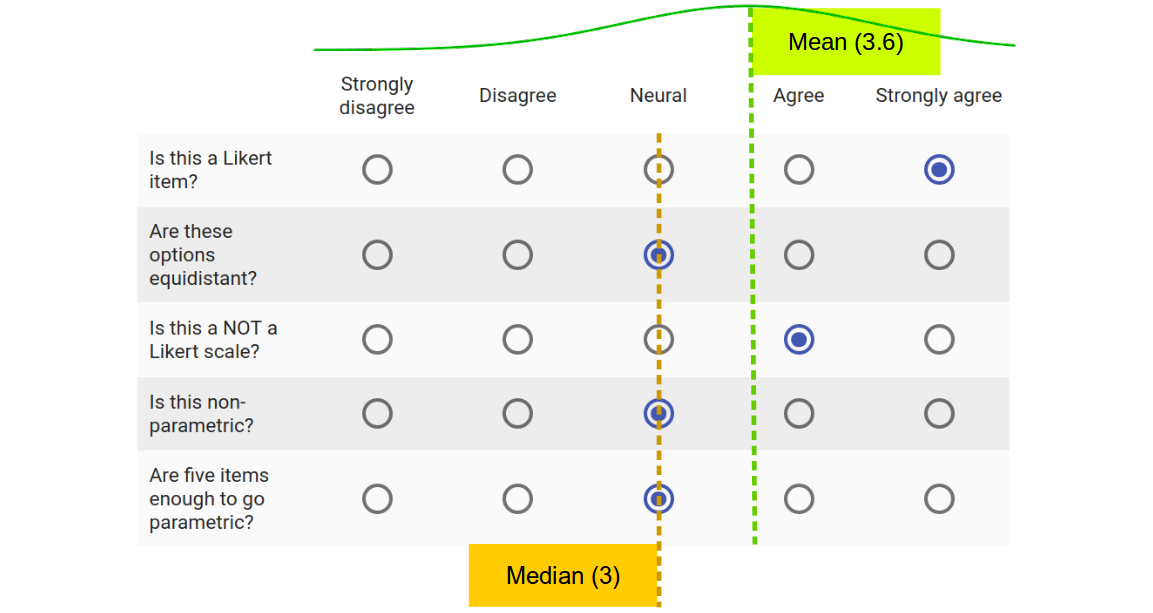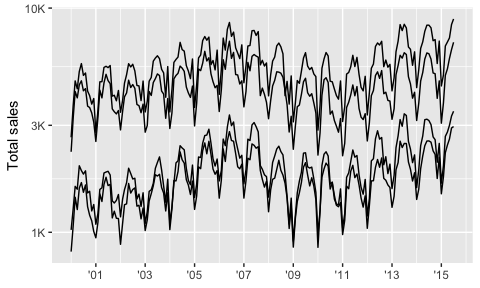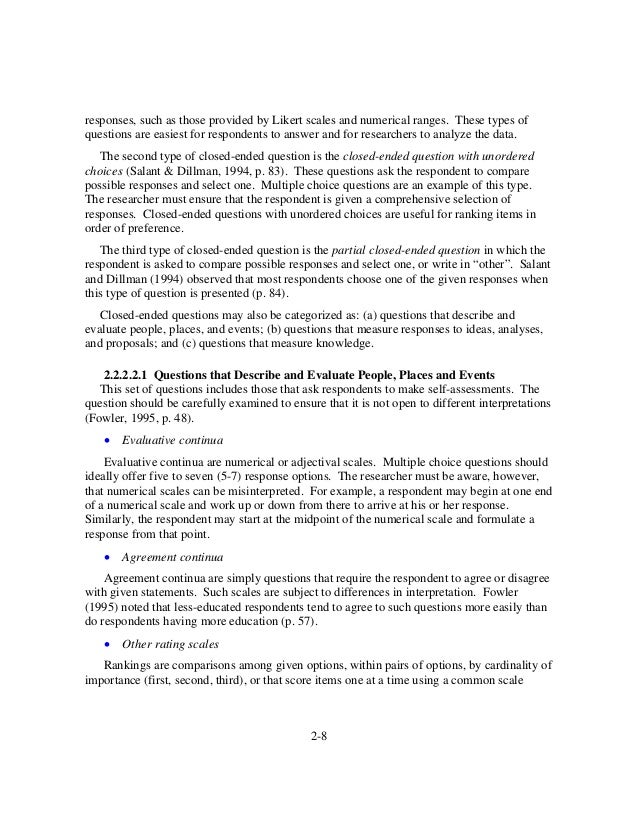45 response scales how many points and what labels
Choosing response scale labels and length - ResearchGate Jul 5, 2022 — PDF | There has been much debate over the optimal format for scales, particularly in regard to two key issues - the labelling of points and ... What Is the Best Response Scale for Survey and Questionnaire Design ... points use for their survey and questionnaire. Taken as a whole this study suggests using of seven-point rating scale and if there is a need to have respondent to be directed on one side, then six-point scale might be the most suitable. Key Words Response Scale, Rating Scale, Attitude Scale, Liker Scale, Scaling Method, Response Rate,
Employee Performance Rating Scales in 2022: Examples & Definitions Overall performance ratings are given on a 5-point scale, observing employees with performances that are: 5 = Leading. 4 = Strong. 3 = Solid. 2 = Building. 1 = Not Meeting Expectations. Goals are also tracked using a 3-point rating scale that measures whether a goal or project was on time, on budget, and accomplished.
Response scales how many points and what labels
Likert Scale Response Options A Likert-type scale involves a series of statements that respondents may choose from in order to rate their responses to evaluative questions (Vogt, 1999). Sample Likert Scales - Marquette University 3 - Occasionally, in about 30% of the. chances when I could have. 4 - Sometimes, in about 50% of the chances when I could have. 5 - Frequently, in about 70% of the. chances when I could have. 6 - Usually, in about 90% of the chances I could have. 7 - Every time. Level of Problem. 1 - Not at all a problem. Should I label all scale points or just the end ... - Survey Practice by A Maitland · 2009 · Cited by 10 — The approach to labeling should be the one that most clearly defines the response scale for respondents. One might argue that labeling of all scale points might ...
Response scales how many points and what labels. PDF Typical Survey Response Scales - STLHE n Bipolar scales (Disagree to Agree) have a maximum reliability and validity at 7 points whereas unipolar scales (e.g., Not True at all to Completely True) have a maximum reliability and validity at 5 points (Krosnick & Fabrigar, 2003) n Numeric labels seem to increase confusion rather than verbal labels (Krosnick & Fabrigar, 2003) Your Guide to Rating Scale Questions in 2022 - Qualtrics The scale's points should map as closely as possible to the underlying idea (construct) of the scale. Also, the scale should give enough points to differentiate respondents from one another as much as validly possible. It should be easy to interpret the meaning of each scale point - i.e. the meaning of scale points should be interpreted ... User Experience Rating Scales with 7, 11, or 101 Points: Does It Matter? There were no significant differences in internal consistency (measured with coefficient alpha, an estimate of scale reliability) for multi-item scales composed of the test items (ranging from 0.79 for three response options to 0.86 for 11 response options—coefficient alphas greater than 0.70 indicate acceptable scale reliability). Survey Scale: Definitions, Types + [Question Examples] - Formpl In a graphic rating scale, the answer options provided are placed on a scale of 1-3, 1-5, and so on. Respondents can choose an option on the scale that reflects their rating for a specific assertion in the data collection context. A good example of this type of rating scale is the Likert scale . Graphic Rating Scale Question Sample
What is a Likert Scale? Definition, Examples, and Usage - SurveyLegend Most researchers agree that the best Likert scales are the 5-point and 7-point varieties. This simply refers to how many responses the person has to choose from. Most Likert scales you see are going to be odd-numbered. They will have an equal number of positive and negative responses on either side of a neutral response. How to Label Response Scale Points in Your Survey | Qualtrics Here's an example of a seven-point bipolar scale where, through the use of appropriate modifiers, all responses are mutually exclusive of one another. Finally, to ensure that you get the highest-quality data possible, keep these four guidelines in mind as you practice labeling response scales: the effect of labeling and numbering of response scales on the by G Moors · Cited by 106 — random, it is of great concern to any survey researcher. Response bias is a ... Deciding on whether and how to label and/or number the response scale is a. PDF Response scales - UIC Numerical labels or unlabeled scale points are open to interpretation (that we may not want) Numbers assigned to scale points may unintentionally influence responses Unlabeled scale points are even more ambiguous and potentially open to interpretation Interpreting unlabeled scale points takes additional cognitive effort
5 Point Likert Scale Analysis, Interpretation and Examples - PPCexpo The 5-point Likert scale contains 5 response options that will consist of two extreme sides and a neutral option linked to the middle answer options. Examples of a 5-point rating scale for measuring satisfaction are: Very Satisfied, Satisfied, Neutral, Dissatisfied, and Very Dissatisfied. Survey Response Scales - Answer Format and Types of Questions - Explorable Three-point, five-point, and seven-point scales are all included in the umbrella term "rating scale". A rating scale provides more than two options, in which the respondent can answer in neutrality over a question being asked. Examples: 1. Three-point Scales Good - Fair - Poor Agree - Undecided - Disagree Extremely- Moderately - Not at all Likert Scale Response Anchors - Sawtooth Software Below are some popular Likert-type scales that you can use in your Sawtooth Software CiW (general interviewing) questionnaires. Level of Acceptability Totally unacceptable Unacceptable Slightly unacceptable Neutral Slightly acceptable Acceptable Perfectly Acceptable Level of Appropriateness Absolutely inappropriate Inappropriate Survey rating scales 1-5: Understand your audience better Rating scales range from super simple to highly complex. Each rating scale can be used to gather specific data. Here's a list of five common rating scales and how they can be used in surveys: Likert scale. Participants rate their level of agreement to items that describe a topic, like customer satisfaction, usability, or loyalty.
Survey Response Scales: How to Choose the Right One | CXL How you design a survey or a form will affect the answers you get. This includes the language you use, the order of the questions, and, of course, the survey scale: the default values and ranges you use. Survey response scales can be embedded in the survey (e.g., 1-5, 1-10, etc.), chosen via a drop-down menu, or included as part of the survey language.
Color, Labels, and Interpretive Heuristics for Response Scales These items asked respondents to rate how successful, happy, overweight, nervous, fit, and moody they were on seven-point scales, with the endpoints labeled "Not at all _______" and "Very ________" (for example, "Not at all successful" and "Very successful"). The first item had been used by Schwarz and his colleagues (Schwarz et al., 1991 ).
15 Common Rating Scales Explained - MeasuringU The classic Likert item uses a 5-point response scale, but you can use 7, 9, or other points, too. (Although someone will have a strong opinion about the "right" number of steps.) Because the response scale is about agreement, be sure items are phrases participants can agree or disagree to.
The 4,5, and 7 Point Likert Scale + [Questionnaire Examples] - Formpl To interpret a 4 point scale, assign each response a point value, from 1 to 4, based on the number of responses. Common values for the options start with "strongly disagree" at 1 point and "strongly agree" at 4. Create a table for your results and find the Mode (number of times something occurs) and the average response (Mean).

Can I use parametric analyses for my Likert scales? A brief reading guide to the evidence-based ...
A classification of response scale characteristics that affect data ... In total, they considered more than 280 possible choices, among which 40 choices are related to the design of the scale and belong to 17 characteristics. Table 2 in Appendix provides the list of response scales' characteristics and the choices considered by these authors.
Choosing Response Scale Labels and Length - DRO by P Darbyshire · 2004 · Cited by 50 — There has been much debate over the optimal format for scales, particularly in regard to two key issues. - the labelling of points and the overall length of ...
Working with "Check All That Apply" Survey Data (Multiple Response Sets ... In our example data, we used the number 1 to indicate "present", so we want to count the number of 1's a person has across the four multiple response variables. We can use Count Values Within Cases to count the number of "checked boxes" for a given respondent. If someone does not have any 1's, they will have a count of 0.
A Search for the optimum feedback scale Thus when defining an optimum response scale it is important to consider scales which are frequently used. The Mayflower organisation 2, which regularly implements surveys, has recommended four five-point scales found to be especially effective: 1) Far too much, too much, about right, too little, far too little.
Likert Scale: Whats, Whys, Hows & Everything to know in 2022 - SurveySensum If you want to understand the intensity of the customer's positive or negative response or want to add more variants, then the 7-point scale is preferred. Create a 5 POINT LIKERT SCALE survey for FREE b) 7-point Likert Scale A 7-point Likert Scale is legendary and has been used since 1932.
Survey Rating Scales to Guide Survey Respondents Effectively Five point scales are most popular followed by seven point scales. These scale ranges tend to work best. Beyond a 7 point scale participants have trouble responding the same way if they repeated the survey, so we recommend staying away from anything above 7 points. Here is an example of a 5 point Likert Rating Scale: Strongly disagree Disagee
Can I use parametric analyses for my Likert scales? A brief reading guide to the evidence-based ...
The Effect of Rating Scale Format on Response Styles: the Number of ... numbers of response categories and varying label formats (e.g., 7-point rating scales labeled at the endpoints, fully labeled 5-point scales, etc.) but have few guidelines when selecting a specific format. Drawing from the literature on response styles, we formulate hypotheses on the effect of the labeling of response categories and the
20 Free Ready-Made Survey Rating Scale Examples - AidaForm The most commonly used Graphic Scales indicate the answer options on a scale of 1 to 10 and 1 to 5. The stars and numbers represent a quantity that can be averaged and analyzed similarly to Linear Numeric Scales. How would you rate your experience with AidaForm website? 1 - Awful, 3 - Neutral, 5 - Great
4 Measurement Scales Every Researcher Should Remember A Likert scaletypically contains an odd number of options, usually 5 to 7. One end is labeled as the most positive end while the other one is labeled as the most positive one with the label of 'neutral' in the middle of the scale. The phrases 'purely negative' and 'mostly negative' could also have been 'extremely disagree' and 'slightly disagree'.
Should All Scale Points Be Labeled? - MeasuringU For example, coming up with labels for each of the points on the eleven-point Likelihood to Recommend item would likely be impractical; endpoints and a neutral label may be all that can be done. But labeling each response option for five- and seven-point scales is practical and a fairly common practice.
Survey rating scales: numbered vs worded lists | SurveyMonkey Another strength to a word scale is the flexibility in its scoring. With worded labels, the researcher has the freedom to score and label categories however they feel without confusing the respondent. Scaling can also be unbalanced, and the scoring could look something like this: Extremely Good = 10. Very Good = 8.
Rating Scale and Balance Questions for Your Survey - Snap Surveys Blog A balanced scale will have an equal number of positive and negative responses with a neutral rating and a "no opinion" rating. Unbalanced Scale Question: If there are many more positive than negative evaluations or vice versa, an unbalanced scale will provide greater discrimination amongst responses for the same number of points on the scale.













Post a Comment for "45 response scales how many points and what labels"